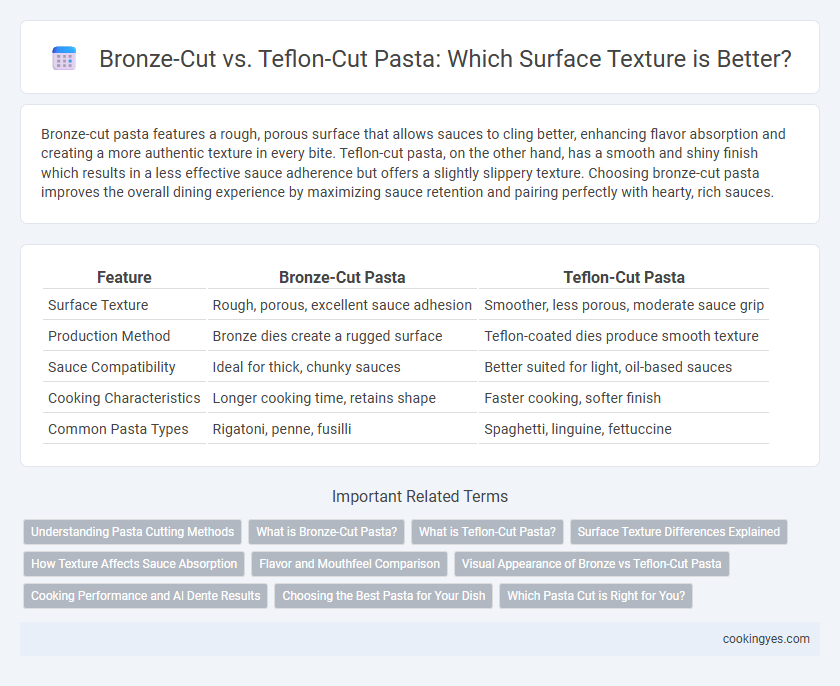Bronze-cut pasta features a rough, porous surface that allows sauces to cling better, enhancing flavor absorption and creating a more authentic texture in every bite. Teflon-cut pasta, on the other hand, has a smooth and shiny finish which results in a less effective sauce adherence but offers a slightly slippery texture. Choosing bronze-cut pasta improves the overall dining experience by maximizing sauce retention and pairing perfectly with hearty, rich sauces.
Table of Comparison
| Feature | Bronze-Cut Pasta | Teflon-Cut Pasta |
|---|---|---|
| Surface Texture | Rough, porous, excellent sauce adhesion | Smoother, less porous, moderate sauce grip |
| Production Method | Bronze dies create a rugged surface | Teflon-coated dies produce smooth texture |
| Sauce Compatibility | Ideal for thick, chunky sauces | Better suited for light, oil-based sauces |
| Cooking Characteristics | Longer cooking time, retains shape | Faster cooking, softer finish |
| Common Pasta Types | Rigatoni, penne, fusilli | Spaghetti, linguine, fettuccine |
Understanding Pasta Cutting Methods
Bronze-cut pasta features a rough, porous surface that enhances sauce adhesion by creating microscopic grooves, resulting in a more flavorful dish. Teflon-cut pasta, produced with non-stick surfaces, yields a smoother texture that can be less effective at holding sauces but offers a more uniform shape and faster production. Understanding these cutting methods helps pasta enthusiasts select the ideal texture for specific recipes, balancing sauce retention and cooking efficiency.
What is Bronze-Cut Pasta?
Bronze-cut pasta is made by extruding dough through bronze dies, resulting in a rough, porous surface that better holds sauces and enhances flavor absorption. This traditional method creates a coarse texture favored in artisanal pasta due to its superior sauce adherence compared to the smoother, non-stick finish of Teflon-cut pasta. Bronze-cut pasta typically has a more authentic and rustic mouthfeel, promoting a richer culinary experience in Italian cuisine.
What is Teflon-Cut Pasta?
Teflon-cut pasta features a smooth surface created by extrusion through Teflon-coated dies, resulting in a sleek texture that prevents sauce from adhering as strongly. Unlike bronze-cut pasta, which has a rough, porous surface ideal for holding sauces, Teflon-cut pasta offers a more delicate and polished appearance. This manufacturing method typically produces pasta with a shiny finish and a slightly slippery mouthfeel.
Surface Texture Differences Explained
Bronze-cut pasta features a rough, porous surface texture that enhances sauce adhesion by allowing the sauce to cling better, resulting in a more flavorful bite. In contrast, Teflon-cut pasta is smoother and less porous, causing sauces to glide off more easily and delivering a lighter texture. The distinct surface textures created by these manufacturing methods directly influence how well pasta absorbs and holds sauces, impacting the overall taste experience.
How Texture Affects Sauce Absorption
Bronze-cut pasta features a rougher, porous surface that enhances sauce adhesion and absorption, intensifying flavor in each bite. Teflon-cut pasta has a smoother texture, causing sauces to glide off more easily and reducing overall sauce retention. This difference in surface texture significantly influences the pasta's ability to hold thicker or chunkier sauces effectively.
Flavor and Mouthfeel Comparison
Bronze-cut pasta features a rough, porous surface that holds sauces more effectively, enhancing flavor absorption and providing a robust mouthfeel with a slightly al dente bite. Teflon-cut pasta has a smooth, polished texture that results in a slicker surface, causing sauces to slide off and delivering a softer, less textured chew. The choice between bronze-cut and Teflon-cut pasta significantly influences the taste experience and mouthfeel, with bronze-cut preferred for richer, sauce-heavy dishes.
Visual Appearance of Bronze vs Teflon-Cut Pasta
Bronze-cut pasta features a rough, porous surface that holds sauces effectively and creates a rustic, artisanal visual appeal with matte, textured ridges. Teflon-cut pasta presents a smooth, glossy finish resulting in a more uniform shape and a polished, refined appearance but less sauce adhesion. The distinct surface textures influence not only the pasta's taste experience but also its aesthetic presentation on the plate.
Cooking Performance and Al Dente Results
Bronze-cut pasta features a rougher surface texture that better holds sauces and enhances cooking performance by allowing water to penetrate evenly, resulting in superior al dente texture. Teflon-cut pasta has a smoother surface, which may lead to less sauce adherence and a softer bite after cooking. The choice of bronze-cut ensures firm, textured pasta that maintains optimal chewiness during cooking, essential for classic Italian al dente results.
Choosing the Best Pasta for Your Dish
Bronze-cut pasta features a rough, porous surface that allows sauces to cling better, enhancing flavor absorption and texture in traditional Italian dishes. Teflon-cut pasta, with its smooth and glossy finish, offers a more slippery texture suitable for delicate sauces or lighter preparations. Selecting bronze-cut pasta is ideal for robust, hearty sauces, while teflon-cut pasta complements subtle, creamy sauces, optimizing the overall dining experience.
Which Pasta Cut is Right for You?
Bronze-cut pasta features a rough, porous surface that holds sauces better, ideal for rich, thick sauces or hearty dishes. Teflon-cut pasta offers a smoother texture, suited for lighter sauces and quicker cooking times. Choosing between bronze-cut and teflon-cut depends on the sauce consistency and dish style you prefer for optimal flavor absorption.
Bronze-cut vs Teflon-cut for surface texture Infographic

 cookingyes.com
cookingyes.com